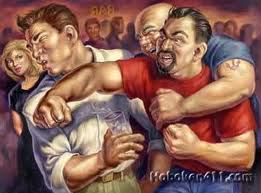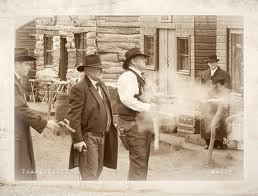Jacqui Murray's Blog, page 183
August 27, 2012
Writer’s Tip #19: Give Your Characters Their Heads

Wanna be a writer? Read on.
When you read your story, does it sound off, maybe you can’t quite put your finger on it, but you know you’ve done something wrong? Sometimes–maybe even lots of times–there are simple fixes. These writer’s tips will come at you once a week, giving you plenty of time to go through your story and make the adjustments.
Today’s tip: Let your characters direct their story.
Who do you love hanging out with in your real life? People who are fun, surely, and those who are unpredictable. Isn’t it enervating to see what they do next?
That’s what must be in your characters. They are fully-fleshed with dreams and passions, but they are also individuals. Surprise yourself with their reactions to events in your story and you’ll keep your readers turning pages. The moment you can see any well-planned surprise, chances are, so will your sophisticated reader. Think through your characters eyes–not yours–and come up with their uncommon take on events.
To have these tips delivered to your email, click Writer’s Tips here.

Jacqui Murray is the editor of a K-6 technology curriculum, K-8 keyboard curriculum, creator of two technology training books for middle school and six ebooks on technology in education. She is the author of Building a Midshipman , the story of her daughter’s journey from high school to United States Naval Academy. She is webmaster for six blogs, an Amazon Vine Voice book reviewer, a columnist for Examiner.com , Editorial Review Board member for Journal for Computing Teachers, Cisco guest blog, Technology in Education featured blogger, IMS tech expert, and a bi-weekly contributor to Write Anything. Currently, she’s editing a thriller that should be out to publishers next summer. Contact Jacqui at her writing office or her tech lab, Ask a Tech Teacher.
Filed under: characters, writers tips Tagged: characters, writers tips

August 24, 2012
How to Describe Your Character’s Home II
It’s been a few years since I last discussed houses. I have a lot more to say about this topic now (mostly because I’ve read about 214 books since then, often being inspired by descriptions from my successful colleagues).
A home tells as much about a character as a long narrative about their background and personal history–in a more interesting fashion. By discussing the choices s/he makes in decor, furniture, nick-nacks, cleanliness, you as writer speak volumes about the motivations and core of the people in your book, develop empathy with the reader, and make them likable or feared.
Here are some of my favorite ‘home’ descriptions organized by:

Is this your character’s home? Maybe for Lord Hawke.
Outside
Inside
Room
Yard
Bathroom
Doors
Entry
Walls
Windows
Furniture
Sensory
As with all my descriptors, don’t use these verbatim!. They are some other author’s intellectual property. Use them for inspiration. See how others have done it so you can create your own unique path.
Overall

Do you see a dinner party in this room?
Fair-sized house built of red Lyons Sandstone with the most god-awful-looking picket fence I’d ever seen.
Small upstairs apartment on Newport Island, a tiny piece of land accessible only by a bridge so narrow, it would admit just one car at a time.
The weather-beaten slat cottage sat at the far end of a mostly brown lawn. Wood silvered by the sun. Roof shingles warped. Small stands of plantain and giant bird-of-paradise for privacy.
Rambling old farm house
Gleamed with the spotless silence of for-company-only.
He leaned on the old boards. They felt thin and veined, frozen by a hundred winters, baked by a hundred summers. They smelled of dust and age.
A big house, the kind in which most American kids dreamed of growing up. Secluded among trees on one of DC’s most exclusive streets, it had turrets, gables, dormers, balconies, a screened-in front porch, a free-standing garage, a gazebo, a pool, formal gardents, the American dream.
Sturdy two-story residence designed without the least imagination
Outside

Or is this closer? Barely making it.
Were columns and friezes and arched windows twenty feet high
It might once have been nice; it might once have been the home of an actual family. But scrub and tall weeds now covered the yellowed lawn, which clearly hadn’t been cut in years. A wire fence bordered the property, sagging at spots where the wind had knocked it down, a wooden gate hanging from its post.
Set far back from the curb, beneath three tower pines. It was white plaster with a brown tile roof and Castillian wrought iron over the windows.
The house was an old brown tumbledown wreck, its clapboard weathered and cracked, several roof shingles missing
Beyond them rough hills sloping into the sharp blue Pacific
Perimeter of the grounds was patrolled by armed security, and every inch of the property was wired with cameras, security lighting, and motion sensors.
Yard
Weed-choked courtyard
Home. eight acres of scrub and savannah, a pasture and paddock, a pond, a stream, avocado, lemon and orange trees loaded with fruit.
It was abandoned. It had a mailbox entirely hidden by tall grass. Its driveway was overgrown. It had bushes and brambles up against the door and the windows. It had weeks in the gutters, and green slime on the walls, and a cracked foundation pierced by creeper tendrils thicker than my wrists.
Room

Could you get comfortable here?
Small with clean white walls, a twin bed, a desk with a blank blotter on it, sliding closets opposite the bed, and thin green shag carpet.
My Writing Area: My computer faces out the window. I like having the sky and buildings in the background. Occasionally a bird or plane flies by in the distance. To my far left is my 42″ flatscreen TV (size does matter), which often displays my daily dose of CNN or Grey’s Anatomy. Next to that is my Buddhist altar, which I need to make better use of. To my right is a framed poster displaying a poem of mine that had been on Chicago buses and trains. And to the far right is a black and white picture of Grand Central Station with wide beams of light gushing in through the windows. The beams look like they are about to make the commuters levitate at any minute and float skyward.
A single light burned, casting light on a chintz couch and an antique Quaker chair
Improvised kitchenette off to one side
Walls and ceilings were covered with mirrors, a high-tech bordello.
Furnishings were cheap, black-painted. A worn mustard-yellow bean-bag chair, a relic of the seventies. An old tape deck and a towering set of speakers whose cloth was fraying
Door
A front door that could accommodate a family of giraffes.
Entry
A foyer that would accommodate the Serengeti Plant at the foot of a vast curving staircase that probably went to heaven
Polished wood floors and a graceful banister that curved up toward a soaring second floor gallery.
Persian rug cove red a shopworn carpet.
Walls

Not bad for a room
Prints of gentlemen riding to hounds decorate the walls.
Crumbling rock walls
Windows
Beautiful high arched windows
Velvet drapes framed the windows, the lace inner curtains remained drawn, allowing daylight to enter while rendering the heart-stopping view over the city a blur
bay windows
Bathroom
The bathroom was clean. The tub and the towels were dry. The medicine cabinet above the sink had a mirrored door and behind it were over-the-counter analgesics, and toothpaste, and tampons, and dental floss, and spare soap and shampoo.
Furniture, etc.
Uses his exercise bike as a clothes rack
Old wooden chair with the two missing back slats
gathered the whole mess and shifted it to the alarmingly large pile tilting dangerously
Locked in shadow in a corner of the room
Brown plaid sofa with heavy oak arms, a bookcase neatly stocked with paperbacks, family pictures on one wall, a china cabinet against another.
beautiful gilded mirror
FBI-approved safe, a four-drawer Mosler combination safe, concrete-and-steel, good for material up to top secret
trestle table
lamps washed the window in a strong incandescent glow
Is this how busy your protagonist is?
He rummaged through the chest. Tshirts were pushed into the top drawer along with more underwear and wadded socks. The next drawer down held a pair of folded sweatpants but nothing else. The final drawer held nothing belonging to the thief, just a stack of well-0fingered brochures and menus from local businesses.
Sensory
Back when home was more than a TV and a microwave
No sound in the house, not even the sounds that houses make: air-conditioning, or furnace, or the stairwell creaking, or the frig cycling on; nothing but a silence that seemed to have been thickening since
doors opened and closed and water ran and toilets flushed and then the house went quiet. The heating system whirred and the taped-up football players muttered and grunted and snored
is your garage like your garden or like your television set?
Watch this slideshow of homes, rooms, personalities. What story do they tell?
Click to view slideshow.
Jacqui Murray is the editor of a K-6 technology curriculum, K-8 keyboard curriculum, creator of two technology training books for middle school and six ebooks on technology in education. She is the author of Building a Midshipman , the story of her daughter’s journey from high school to United States Naval Academy. She is webmaster for six blogs, an Amazon Vine Voice book reviewer, a columnist for Examiner.com , Editorial Review Board member for Journal for Computing Teachers, Cisco guest blog, Technology in Education featured blogger, IMS tech expert, and a bi-weekly contributor to Write Anything. Currently, she’s editing a thriller that should be out to publishers next summer. Contact Jacqui at her writing office or her tech lab, Ask a Tech Teacher.
Filed under: descriptors, writers resources, writing Tagged: homes


August 23, 2012
Check out my Article Over at Write Anything
I have an interesting article over on Write Anything on 5 Great Reasons to Build Your Writer’s Platform Yourself. If you can’t make it–no worries. I’ll post it here soon.
Jacqui Murray is the editor of a technology curriculum for K-sixth grade, creator of two technology training books for middle school and four ebooks on technology in education. She is the author of Building a Midshipman , the story of her daughter’s journey from high school to United States Naval Academy. She is webmaster for six blogs, an Amazon Vine Voice book reviewer, a columnist for Examiner.com , Editorial Review Board member for Journal for Computing Teachers, Cisco guest blog, IMS tech expert, and a bi-weekly contributor to Write Anything. Currently, she’s editing a thriller for her agent that should be out to publishers this summer. Contact Jacqui at her writing office or her tech lab, Ask a Tech Teacher.
Filed under: Guest bloggers, marketing, writers resources Tagged: guest post


August 21, 2012
Tech Tip for Writers #71: Visit Foreign Language Google Search

Writing too technical for you? Read on.
Tech Tips for Writers is an (almost) weekly post on overcoming Tech Dread. I’ll cover issues that friends, both real-time and virtual, have shared. Feel free to post a comment about a question you have. I’ll cover it in a future Tip.
Q: English isn’t my first language. How do I go to Google in other languages?
A: To visit the foreign language Google search engines, type:
Then add the country extension you would like to visit.
For example, Japan is .jp, so if I typed:
…I’d get this:
Cool, hunh?
Questions you want answered? Email me at askatechteacher@structuredlearning.net and I’ll answer it within the next thirty days.
To sign up for Tech Tips delivered to your email, click here.

Jacqui Murray is the editor of a K-6 technology curriculum, K-8 keyboard curriculum, creator of two technology training books for middle school and six ebooks on technology in education. She is the author of Building a Midshipman , the story of her daughter’s journey from high school to United States Naval Academy. She is webmaster for six blogs, an Amazon Vine Voice book reviewer, a columnist for Examiner.com , Editorial Review Board member for Journal for Computing Teachers, Cisco guest blog, Technology in Education featured blogger, IMS tech expert, and a bi-weekly contributor to Write Anything. Currently, she’s editing a thriller that should be out to publishers next summer. Contact Jacqui at her writing office or her tech lab, Ask a Tech Teacher.
Filed under: Uncategorized

August 20, 2012
Writer’s Tip #18: Yeah, You Have to Force Yourself to Write

How to write
When you read your story, does it sound off, maybe you can’t quite put your finger on it, but you know you’ve done something wrong? Sometimes–maybe even lots of times–there are simple fixes. These writer’s tips will come at you once a week, giving you plenty of time to go through your story and make the adjustments.
Today’s tip: Practice makes perfect.
This is from Chuck Palahniuk. I do this, too, so I want to share it with you:
Two years ago, when I wrote the first of these essays it was about my “egg timer method” of writing. You never saw that essay, but here’s the method: When you don’t want to write, set an egg timer for one hour (or half hour) and sit down to write until the timer rings. If you still hate writing, you’re free in an hour. But usually, by the time that alarm rings, you’ll be so involved in your work, enjoying it so much, you’ll keep going. Instead of an egg timer, you can put a load of clothes in the washer or dryer and use them to time your work. Alternating the thoughtful task of writing with the mindless work of laundry or dish washing will give you the breaks you need for new ideas and insights to occur. If you don’t know what comes next in the story… clean your toilet. Change the bed sheets. For Christ sakes, dust the computer. A better idea will come.
Please add comments with your favorite editing fixes.
To have these tips delivered to your email, click Writer’s Tips here.

Jacqui Murray is the editor of a K-6 technology curriculum, K-8 keyboard curriculum, creator of two technology training books for middle school and six ebooks on technology in education. She is the author of Building a Midshipman , the story of her daughter’s journey from high school to United States Naval Academy. She is webmaster for six blogs, an Amazon Vine Voice book reviewer, a columnist for Examiner.com , Editorial Review Board member for Journal for Computing Teachers, Cisco guest blog, Technology in Education featured blogger, IMS tech expert, and a bi-weekly contributor to Write Anything. Currently, she’s editing a thriller that should be out to publishers next summer. Contact Jacqui at her writing office or her tech lab, Ask a Tech Teacher.
Filed under: writers, writers tips Tagged: write, writers tips

August 17, 2012
Book Review: Bryson’s Dictionary for Writers and Editors
 Bryson’s Dictionary for Writers and Editors
Bryson’s Dictionary for Writers and Editors
by Bill Bryson
My rating: 5 of 5 stars
If Bernstein’s the acknowledged expert on English grammar, Bill Bryson is the most famous living expert who share’s his knowledge with a pinch of humility and humor.
I met Bryson reading his Short History of Nearly Everything. Therein lay the seeds of my initial distrust. How could an author who wrote such an enthralling historic book like Short History switch genres and write a successful dictionary? Shouldn’t that be the job of a bibliophile or Mr. Webster’s great grandson? Despite my misgivings, I decided to give it a try. Anyone who could distill history into 480 pages must have the see-the-forest-for-the-trees ability to decide on the need-to-know grammar required for a budding author. After all, I needed to spend the minutes stolen from my day job on what would quickly kick-start my authorial expertise. I’d get to ‘everything’ later.

So, despite my misgivings and with a nod for the appeal of humor in the dry world of word study, I bought Bryson’s Dictionary for Writers and Editors (Broadway Books, 1994). It didn’t disappoint. As Bill Bryson notes, it will provide you with “the answers to all those points of written usage that you kind of know or ought to know but can’t quite remember.” It not only includes dictionary-appropriate word meanings, but factual details that writers might get wrong. On the one hand, he discusses the difference in meaning between ‘a’ and ‘an’, and then later, he shares the meaning of Au secours! (a cry for help). He seems to include 1) whatever struck him as interesting or relevant based on his own personal writing experiences, and 2) what he considers critical to be a successful writer–well-beyond plot, characters and story arc. Many entries have his notes/definitions/explanations, but some include just the word, there for a writers’ ruminations. To that end, the book is a fascinating stroll through Bryson’s writing mind.
Here are some of the gems I found:
the difference between ‘autarchy’ and ‘autarky’
‘auxiliary’ has one ‘l’
the difference between ‘avenge’ and ‘revenge’
difference between ‘before’ and ‘prior to’
what BMW stands for
difference between ‘bimonthly’ and ‘biweekly’
what is carpaccio
‘chickenpox’ is one word
how to translate Chinese names to English
difference between ‘compare to’ and ‘compare with’
difference between ‘compel’ and ‘impel’
what does ‘Dum spiro, spero‘ mean (‘While I breathe, there is hope.’)
difference between ‘fewer’ and ‘less’ (the former covers singular nouns; the latter, plural)
the difference between ‘gibe’ and ‘jibe’
what’s a ‘haggis’ (Scottish dish)
‘Lacy’ has no e
‘Laddie’ isn’t spelled ‘laddy’
what’s a ‘macaronic verse’ (a type of poetry in which two or more languges are mingled)
what’s ‘ochlocracy’? (government by mob)
difference between ‘regretfully’ and ‘regrettably’
Jacqui Murray is the editor of a K-6 technology curriculum, K-8 keyboard curriculum, creator of two technology training books for middle school and six ebooks on technology in education. She is the author of Building a Midshipman , the story of her daughter’s journey from high school to United States Naval Academy. She is webmaster for six blogs, an Amazon Vine Voice book reviewer, a columnist for Examiner.com , Editorial Review Board member for Journal for Computing Teachers, Cisco guest blog, Technology in Education featured blogger, IMS tech expert, and a bi-weekly contributor to Write Anything. Currently, she’s editing a thriller that should be out to publishers next summer. Contact Jacqui at her writing office or her tech lab, Ask a Tech Teacher.
Filed under: book reviews, writers resources Tagged: book review, Dictionary, research

August 15, 2012
9 Reasons Why Readers Stop Reading

I can’t read this anymore!
I rarely stop reading a book once I’ve started. Once I’ve committed, I hate to think I’ve wasted the time already spent and, anyway, the story surely will improve or it wouldn’t have been published.
There are nine reasons why I do stop, though.
Characters aren’t likable.
Plot develops too slowly
Plot is too complicated. I don’t understand what’s going on. There are too many pieces that don’t seem to be connected well enough. I can’t keep up.
Plot is unrealistic (and it isn’t a science fiction story. Even those should inspire me to willingly suspend my disbelief)
No hook. You’ve created a dazzling plot, great believable characters, set in a perfectly-described scene, but forgot the hook. Why does the reader care? Will he learn something? Is this a common problem that a lot of readers can relate to? Whatever the hook, it has to be there and be good.
Author is preachy. I don’t want the author’s opinions on a subject for more than a paragraph. If I wanted preaching, I’d attend a sermon. Same goes for politics. For many, reading is an escape from politics. Let them escape (unless of course, it’s a political novel like Alan Drury. Then by all means, go get ‘em)
I can’t see what’s going on. The author hasn’t sufficiently fleshed out the scenery, nor filled my senses with the world inhabited by the story’s characters
Author didn’t do his/her research. I’ve caught too many errors and no longer trust what the author is telling me. This is especially important in historic fiction–critical, even. A writer can make one mistake, but two is a trend. Three is an end.
Author made mistakes. A character has red hair one scene and black the next. It was a drizzly day when the chapter opened and the characters dress for summer–for no reason.
One I used to consider deadly was POV switches. I hated when the author jumped in and out of characters heads with abandon. Unfortunately, I see that all too often even in good writers’ books, so I must be more tolerant. That’s a trait that doesn’t come easily to me.
What are your reasons?
Jacqui Murray is the editor of a K-6 technology curriculum, K-8 keyboard curriculum, creator of two technology training books for middle school and six ebooks on technology in education. She is the author of Building a Midshipman , the story of her daughter’s journey from high school to United States Naval Academy. She is webmaster for six blogs, an Amazon Vine Voice book reviewer, a columnist for Examiner.com , Editorial Review Board member for Journal for Computing Teachers, Cisco guest blog, Technology in Education featured blogger, IMS tech expert, and a bi-weekly contributor to Write Anything. Currently, she’s editing a thriller that should be out to publishers next summer. Contact Jacqui at her writing office or her tech lab, Ask a Tech Teacher.
Filed under: characters, plot, pov, reading, research, setting, writers resources, writers tips, writing Tagged: Plot (narrative), readers, writers, writers resources


August 14, 2012
Tech Tip for Writers #70:Make your desktop icons Big or Little

The tech side of writing
Tech Tips for Writers is an (almost) weekly post on overcoming Tech Dread. I’ll cover issues that friends, both real-time and virtual, have shared. Feel free to post a comment about a question you have. I’ll cover it in a future Tip.
Q: Somehow, my desktop icons got tiny (or huge). I’ve checked all the icon properties, but no joy. How do I fix that?
A: I had to learn this one because students messed up the lab desktops. I don’t think they meant to, just did it while doing something else and didn’t know how to undo.
Here’s what you do:
click and drag a box around all the icons that are sized wrong on the desktop
Push Ctrl while you scroll the mouse wheel up or down. You’ll see the selected group get bigger or smaller.
Stop when they’re the size you like.
Questions you want answered? Fill out the form below:
[contact-form]

Jacqui Murray is the editor of a K-6 technology curriculum, K-8 keyboard curriculum, creator of two technology training books for middle school and six ebooks on technology in education. She is the author of Building a Midshipman , the story of her daughter’s journey from high school to United States Naval Academy. She is webmaster for six blogs, an Amazon Vine Voice book reviewer, a columnist for Examiner.com , Editorial Review Board member for Journal for Computing Teachers, Cisco guest blog, Technology in Education featured blogger, IMS tech expert, and a bi-weekly contributor to Write Anything. Currently, she’s editing a thriller that should be out to publishers next summer. Contact Jacqui at her writing office or her tech lab, Ask a Tech Teacher.
Filed under: tech tips for writers Tagged: icons, tech tips, tip, writers

August 13, 2012
Writer’s Tip #17: Use Dialogue Correctly
 When you read your story, does it sound off, maybe you can’t quite put your finger on it, but you know you’ve done something wrong? Sometimes–maybe even lots of times–there are simple fixes. These writer’s tips will come at you once a week, giving you plenty of time to go through your story and make the adjustments.
When you read your story, does it sound off, maybe you can’t quite put your finger on it, but you know you’ve done something wrong? Sometimes–maybe even lots of times–there are simple fixes. These writer’s tips will come at you once a week, giving you plenty of time to go through your story and make the adjustments.
Today’s tip: Use dialogue for character development; put exposition and story details into action scenes
There are a lot of rights and wrongs of dialogue. This one you might not have been aware of. It’s from Screenwriting U, but fits us fiction writers as well.
Beginning writers often fill their dialogue with exposition and story details, thus reducing the amount of character and creativity that shows up in that dialogue. Don’t do it.
Instead, put the exposition, information, and story details into the action and situations.
For example, instead of a trainer telling a new boxer that a certain philosophy doesn’t work, have him put the character in the boxing ring and learn it by having his ass kicked. Now, the trainer doesn’t have to lecture. In fact, he is free to talk about anything – breakfast, politics, his favorite dog, etc. – because the real meaning is being delivered through the action.
Please add comments with your favorite dialogue fixes.
To have these tips delivered to your email, click Writer’s Tips here.

Jacqui Murray is the editor of a K-6 technology curriculum, K-8 keyboard curriculum, creator of two technology training books for middle school and six ebooks on technology in education. She is the author of Building a Midshipman , the story of her daughter’s journey from high school to United States Naval Academy. She is webmaster for six blogs, an Amazon Vine Voice book reviewer, a columnist for Examiner.com , Editorial Review Board member for Journal for Computing Teachers, Cisco guest blog, Technology in Education featured blogger, IMS tech expert, and a bi-weekly contributor to Write Anything. Currently, she’s editing a thriller that should be out to publishers next summer. Contact Jacqui at her writing office or her tech lab, Ask a Tech Teacher.
Filed under: characters, dialogue, writers tips Tagged: characters, dialogue, writers tip

August 10, 2012
How to Describe a Fight
Ever wonder how to describe the violence of a fight between two characters in your story–if you’re not a fighter? I’m not so I took note of how my favorite thriller characters did this–people like Jack Reacher. I realize it’s not so much about

Physical or verbal? This post deals with the physical.
the wham-bam as the focus, the preparation, the concentration that goes into success.
Here are some samples. As with all my descriptors, don’t use these verbatim!. They are some other author’s intellectual property. Use them for inspiration. See how others have done it so you can create your own unique path.
Hand-to-hand
And charged. He threw up his forearms like an offensive lineman blocking a defensive back, but Pike slipped to the side, pushed the man’s elbow down and away, caught his head, and rolled him into the floor. Third of a second once contact was made, and Pike was on his feet, watching the muscular man rush toward him in slow motion as the three other men, even more slowly, jumped to their feet. The muscular man reached under his shirt even as he pushed past the tables. Pike did not try to stop the gun; he rolled his hand under the man’s wrist, drove the man’s arm over and back, and pulled him backward and down. Pike had the gun before the man slammed into the floor, and hit him on the forehead with it two hard times.
He put out a nice stiff left, which he planned to follow with a right cross. I slipped to the left, which threw him off enough so that I could step inside the right cross and get a handful of his hair. I pulled his head forward and broke his nose with my head. Still holding his hair in one hand, I got my other hand into his crotch and put my shoulder into him and lifted him off the ground and slammed him down on the hood of the truck. He grunted, and went limp. When I stood back, he slowly slid off the hood and lay in the street with his mouth open
Wells tackled him, a linebacker drilling a quarterback from the blindside, a clean shoulder-to-shoulder hit that arched Marley’s spine. The gun clattered from his hand and skittered into the drainage ditch. Wells kept coming, driving his legs, finishing the hit.
He smashed an elbow into the side of Marley’s skull, the soft spot high on the temple.
Gun fights used to be all there was
Slapped his right palm down on the man’s face, shattering his nose.
Black rugby shirt swung his chain wildly now, his eyes dropping to check on his friend and then darting back up, with equal measures of fury and terror, to the bearded man in front of him.
Dewey yanked back with his right forearm, snapping the man‘s neck like a tree branch.
He expected it, anticipated it, and in the moments after landing he let his body relax.
His partner was on his hands and knees how, scrambling toward the bed. I caught him and dragged him to his feet and turned my hip as he tried to knee me in the groin. I banged his nose with my forehead and pushed him away and hit him left cross straight right and he fell over on the bed
Took another step forward, crowding him
I slapped him with my open left hand full across the face. It rocked him and he took a step back and then steadied himself, blinking his eyes and staring at me. His headache must have been a starburst.
I hit him a left hand in the V under his ribs where the sternum ends. It paralyzed his diaphragm and he gasped and doubled over and then pitched forward onto the sidewalk.
I grabbed his wrist with my left hand and held his gun hand against his chest, the gun caught under the jacket and I hit him twice more with my right, square in the nose. He sagged and I shoved him away,
Philosophy/quotes

Muscle over mind
Mortal danger brings clarity
Like two scorpions in a bottle
Pain
He absorbed the trauma, swallowing the pain, then kicked his way slowly back to the surface.
Pain was just an illusory sensation that his mind could shut down if it needed to, he told himself. Put it aside.
Techniques
Paralyzes vocal cords with a strike to the neck
Box ears to break their ear drums
Banged together the heads of his two helpers. It sounded like a bat hitting a baseball.
Knives

Classic knife fight
He had a knife. I moved away from him. He was stronger than Ichabod and had a knife. He started toward me. I had my gun in an ankle holster but I didn’t want to start shooting in the middle of the street if I didn’t have to. I took another step back and slid my belt out of my pant loops. I looped it around my left hand so that the buckle end swung loose
Torture
Multiple small incisions on the thighs, all just splitting the skin. He’d then applied the salt
Guns
Bullets tore through the door, sending splinters flying.
Windows shattered, spewing glass shards everywhere
Bullets gouging the walls
Spray of bullets tore through the line of front windows, striking a side wall, shattering a beautiful gilded mirror
The man had seen Jack’s shadow, seen awhisper of movement and dove to the ground. Jack’s bullet went tinto a tree and spewed up a whirlwind of leaves
Ignoring the pain in his thigh, the blood seeping from the cut in his left arm and tried to move as quickly and quietyly as possible
How do you win a gun fight without a gun?
Shoot the smell off a skunk at a hundred yards
Some were home by now having their first drink before dinner. Maybe looking at the paper. Probably none of them were planning to shoot it out with a bunch of sociopaths.
He lunged for Pike’s gun, but Pike rolled his hands down and away with a minor wing chun deflection, and snapped the Python up hard into the bottom of the man’s chin, popping his jaw like a rat trap. The Python flicked again, and this time, Pike hit him in the Adams’ apple. The bagman clutched at his throat, choking. His face turned bright red
Opened up with sharp, recise three-round bursts, their fire guided by the infrared dots visible through their monoculars.
Carver’s reaction was subconscious, automatic. He fired at the man and the backup who came after him.
He never turned his back on a wounded man
After
Badly bruised, lacerations, and at least one of his teeth had recently been knocked out
My hands were sore. I stumbled out into the kitchen and put ice cubes in a bowl and ran some water and put my hands in to soak.
I knocked five of them out—what’s wrong with that—nothing except there were 8.
Recovery
I took a deep breath. It hurt my ribcage. I exhaled, inhaled again, inched my arms under me and pushed myself up on my hands and knees. My head swam. I felt my stomach tighten and I threw up, which hurt the ribs some more. I stayed that way for a bit, on my hands and knees with my head hanging, lik a winded horse. My eyes focused a little better. I could see the snow and the dog’s footprints. I crawled over, got hold of the park bench and slowly got myself upright. Everything blurred for a minute, then came back into focus gain. I inhaled some more and felt a little steadier.
Watch this slideshow of fights. What story do they tell?
Click to view slideshow.
Jacqui Murray is the editor of a technology curriculum for K-sixth grade, creator of two technology training books for middle school and four ebooks on technology in education. She is the author of Building a Midshipman , the story of her daughter’s journey from high school to United States Naval Academy. She is webmaster for six blogs, an Amazon Vine Voice book reviewer, a columnist for Examiner.com , Editorial Review Board member for Journal for Computing Teachers, Cisco guest blog, IMS tech expert, and a bi-weekly contributor to Write Anything. Currently, she’s editing a thriller for her agent that should be out to publishers this summer. Contact Jacqui at her writing office or her tech lab, Ask a Tech Teacher.
Filed under: descriptors, writers resources Tagged: characters, descriptors, fighting, writers resources, writing








